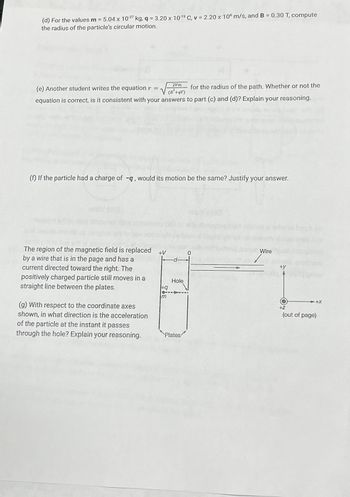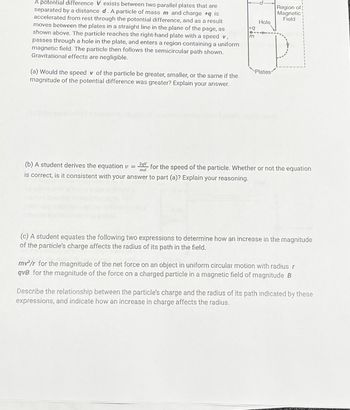of Side View End View (c) In the setup shown above, a coil of wire has a counterclockwise current as shown in the end view. In the side view, the current in the near side of the coil is directed toward the bottom of the page. The coil is near the south pole of the magnet, which is held in place. Does the coil exert an attractive or a repulsive force on the magnet? N Briefly explain your answer. Attractive Repulsive S
of Side View End View (c) In the setup shown above, a coil of wire has a counterclockwise current as shown in the end view. In the side view, the current in the near side of the coil is directed toward the bottom of the page. The coil is near the south pole of the magnet, which is held in place. Does the coil exert an attractive or a repulsive force on the magnet? N Briefly explain your answer. Attractive Repulsive S
Related questions
Question

Transcribed Image Text:N
Briefly explain your answer.
S
Side View
End View
(c) In the setup shown above, a coil of wire has a counterclockwise current as shown in the end view.
In the side view, the current in the near side of the coil is directed toward the bottom of the page. The
coil is near the south pole of the magnet, which is held in place. Does the coil exert an attractive or a
repulsive force on the magnet?
Attractive
S
Repulsive

Transcribed Image Text:A potential difference V exists between two parallel plates that are
separated by a distance d. A particle of mass m and charge +q is
accelerated from rest through the potential difference, and as a result
moves between the plates in a straight line in the plane of the page, as
shown above. The particle reaches the right-hand plate with a speed v,
passes through a hole in the plate, and enters a region containing a uniform
magnetic field. The particle then follows the semicircular path shown.
Gravitational effects are negligible.
(a) Would the speed v of the particle be greater, smaller, or the same if the
magnitude of the potential difference was greater? Explain your answer.
+q
m
2qV
-
md
(b) A student derives the equation v
is correct, is it consistent with your answer to part (a)? Explain your reasoning.
Hole
Plates
Region of
Magnetic
Field
for the speed of the particle. Whether or not the equation
(c) A student equates the following two expressions to determine how an increase in the magnitude
of the particle's charge affects the radius of its path in the field.
mv²/r for the magnitude of the net force on an object in uniform circular motion with radius r
qvB for the magnitude of the force on a charged particle in a magnetic field of magnitude B
Describe the relationship between the particle's charge and the radius of its path indicated by these
expressions, and indicate how an increase in charge affects the radius.
Expert Solution
This question has been solved!
Explore an expertly crafted, step-by-step solution for a thorough understanding of key concepts.
This is a popular solution!
Trending now
This is a popular solution!
Step by step
Solved in 2 steps with 1 images

Follow-up Questions
Read through expert solutions to related follow-up questions below.
Follow-up Question
Thank you so much for the solution. Regarding the second image, it's related to another image. I uploaded the wrong one.

Transcribed Image Text:(d) For the values m = 5.04 x 10-27 kg, q = 3.20 x 10-1⁹ C, v = 2.20 x 106 m/s, and B = 0.30 T, compute
the radius of the particle's circular motion.
2Vm
(e) Another student writes the equation r = √
for the radius of the path. Whether or not the
(B²+qV)
equation is correct, is it consistent with your answers to part (c) and (d)? Explain your reasoning.
(f) If the particle had a charge of -q, would its motion be the same? Justify your answer.
-d
The region of the magnetic field is replaced +V
by a wire that is in the page and has a
current directed toward the right. The
positively charged particle still moves in a
straight line between the plates.
(g) With respect to the coordinate axes
shown, in what direction is the acceleration
of the particle at the instant it passes
through the hole? Explain your reasoning.
+q
m
Hole
Plates
Wire
+y
+Z
+X
(out of page)

Transcribed Image Text:A potential difference V exists between two parallel plates that are
separated by a distance d. A particle of mass m and charge +q is
accelerated from rest through the potential difference, and as a result
moves between the plates in a straight line in the plane of the page, as
shown above. The particle reaches the right-hand plate with a speed v,
passes through a hole in the plate, and enters a region containing a uniform
magnetic field. The particle then follows the semicircular path shown.
Gravitational effects are negligible.
(a) Would the speed v of the particle be greater, smaller, or the same if the
magnitude of the potential difference was greater? Explain your answer.
+q
m
2qV
-
md
(b) A student derives the equation v
is correct, is it consistent with your answer to part (a)? Explain your reasoning.
Hole
Plates
Region of
Magnetic
Field
for the speed of the particle. Whether or not the equation
(c) A student equates the following two expressions to determine how an increase in the magnitude
of the particle's charge affects the radius of its path in the field.
mv²/r for the magnitude of the net force on an object in uniform circular motion with radius r
qvB for the magnitude of the force on a charged particle in a magnetic field of magnitude B
Describe the relationship between the particle's charge and the radius of its path indicated by these
expressions, and indicate how an increase in charge affects the radius.
Solution